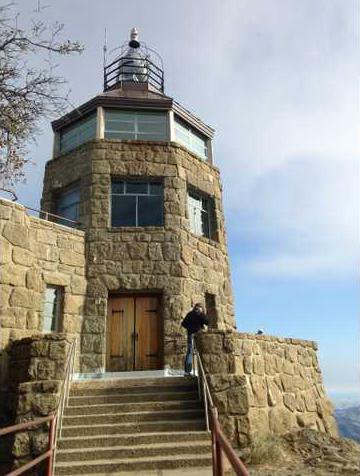At the eastern fringe of the San Francisco Bay Region, Mount Diablo, elevation 3,849 feet, stands alone on the edge of California’s great Central Valley.
At this point, the Coast Range consists only of low hills, none high enough to block the view from the upper slopes of the mountain. As a result, the view is spectacular.
The view from the top
Many visitors to Mount Diablo head straight for the summit to enjoy the famous view. Summer days are sometimes hazy, and the best viewing is often on the day after a winter storm. Then, you can look to the west, beyond the Golden Gate Bridge, to the Farallon Islands; southeast to the James Lick Observatory on Mount Hamilton at 4,213 feet elevation; south to Mount Loma Prieta in the Santa Cruz Mountains at 3,791 feet elevation; north to Mount Saint Helena in the Coast Range at 4,344 feet, and still farther north to Mount Lassen in the Cascades at 10,466 feet.
North and east of Mount Diablo, the San Joaquin and Sacramento Rivers meet to form the twisting waterways of the Delta. To the east beyond California’s great Central Valley, the crest of the Sierra Nevada seems to float in space. With binoculars, you may even be able to pick out Half Dome in Yosemite National Park.
History
Mount Diablo is a sacred mountain to California Indian people. Just about every California Indian community who viewed Mount Diablo would, at one time or another, make a pilgrimage to the summit area for ceremonies. The reason Mount Diablo is so sacred to the California Indian people is that it was the creation point for the Miwok people or genesis for some California Indian people.
Toll roads up the mountain were opened in 1874, and for many years there were two stages every day connecting Walnut Creek and Danville with Mountain House, a 16-room hotel about three miles from the summit. The Stage Road, near Pine Canyon, was one of the original stage-coach line routes. The hotel offered all conveniences and was known for its excellent food.
Wedding ceremonies were a frequent occurrence at the hotel, and celebrities from all over
Europe and America were among the visitors. In those days, it was widely held that you hadn’t seen the West if you hadn’t watched a sunset, sunrise, or full moon from the upper slopes of the mountain.
Business at the hotel declined after the summit observation platform burned in 1891, and shortly thereafter the hotel burned down as well. The toll roads were reopened in 1915, so that the view from the summit was once again available to all.
In 1921, a parcel of land on the mountain was designated a state park, and much of the rest of the mountain was declared a game refuge.
Standard Oil placed a ten-million-candlepower aerial navigation beacon on the summit in 1928. The beacon was so powerful that it could be seen by ships 100 miles at sea. Finally, in 1931, the state acquired more land for Mount Diablo State Park, and the park was formally dedicated and opened to the public
Natural History
Much of the rock that makes up Mount Diablo is sedimentary in origin. It was laid down millions of years ago on the floor of the ocean. Within the last one to two million years, a piece of hard, red 160-million-year-old Franciscan rock was pushed up through six to eight miles of overlying rock and soil, tilting and distorting the rock layers and in some places turning them completely upside down.
As a result, the fossilized remains of many sea creatures, as well as those of mastodons, saber-toothed cats and three-toe horses have been discovered here.
Elevations in the park range from 300 to 3,849 feet. This wide range of elevations creates broad variations in temperature, rainfall and wind exposure that have resulted in a wide variety of plant life on the mountain. Summers are hot and dry, so many people prefer to visit in spring and fall. The park is also popular in winter, when Bay Area residents occasionally enjoy the unusual experience of a snowfall on the mountain’s peak.
Most of the park is typical central California oak and grassland country with extensive areas of chaparral. Riparian woodland occurs on the lower slopes of the mountain, where the streams have water in them throughout most of the year. Several isolated stands of knobcone pine occur within the park, and foothill pine is found in many places. The northernmost groves of coulter pine occur on the lower, northerly slopes of the mountain, near the old mining ghost towns of Nortonville
and Somersville just outside the park. Other trees include the coast live oak, bigleaf maple, California laurel (Oregon myrtle), maul oak, blue oak and buckeye. In all, over 400 species of plants have been identified within the park’s almost 20,000 acres.
Wildlife is also abundant. Coastal black-tailed deer, raccoons, California ground squirrels, eastern fox squirrels and gray foxes are often seen, but striped and spotted skunks, bobcats, mountain lions, coyotes, deer mice, cottontail rabbits, black-tailed hares and many other animals call the mountain home. Mount Diablo is known to harbor red-legged frogs, tarantulas, and the rare Alameda whipsnake, as well as its cousin the northern rattlesnake.





